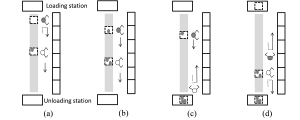Soondo Hong (a 2010 graduate of the lab) continues to develop extension to his dissertation work which modeled and qualified picker blocking in narrow aisle order picking systems. He has now extend this work to consider bucket brigade operations. This paper addresses some of the unique challenges of the bucket brigade setting.
Abstract
This paper we model and quantify picker blocking in bucket brigade order picking systems (OPSs). Bucket brigades improves throughput and reduces variability in OPSs. However, each order picking trip fills different orders and creates workload variation per order. We show that bucket brigade order picking experiences picker blocking when there is a workload imbalance per pick face. We derive a closed-form solution to quantify the level of blocking for two extreme walk speed cases. Additional simulation comparisons validate the picker blocking model which includes backward walk and hand-off delays. We identify the relationship between picker blocking in bucket brigade OPSs and picker blocking in a circular-aisle abstraction of an OPSs in which backward walk and hand-off delays as well as forward walk speed are considered. Our analytical model and simulations verify that aggregating orders into batches smoothes the workload variation by pooling the randomness of picks in each order and that slowest-to-fastest picker sequencing modulates picker blocking between two pickers, i.e., the interaction between neighboring pickers.







